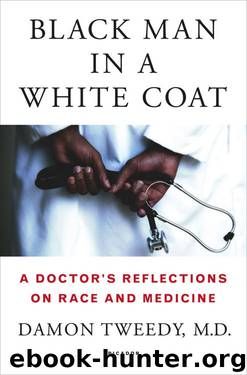Black Man in a White Coat: A Doctor's Reflections on Race and Medicine by Tweedy Damon M.D

Author:Tweedy Damon M.D. [Damon M.D., Tweedy]
Language: eng
Format: epub
ISBN: 9781250044648
Publisher: Picador
Published: 2015-09-08T06:00:00+00:00
7
The Color of HIV/AIDS
“I’ll be damned,” Adam, a medical resident, said, shaking his head. “Our patient in room thirty has been lying.”
We were sitting next to each other in a musty workroom filled with the scent of stressed-out residents and stale pizza. It was seven p.m. Our sister team had admitted the first wave of new patients to the medical ward and was frantically trying to wrap up their work so they could get home. Adam and I were the long-call, overnight team, which meant we’d been on duty for twelve hours and faced another eighteen before we would be set free. I was writing the admission note on an elderly woman who’d come to the hospital that afternoon with a blood clot in her leg. Adam was on the computer looking over the most recent lab results for our patients.
The patient in room thirty, George, had come to our hospital two days earlier complaining of fatigue, weakness, and short-term memory problems. He’d been losing weight and his blood counts were low. In his late forties, he worked at a local, predominately black college that he had graduated from twenty-five years earlier.
George told us he had been healthy his entire life until about six months earlier, when he gradually started feeling tired and had trouble focusing at work. His appetite went away and his weight dropped; he lost twenty pounds without trying. His red and white blood cell counts were abnormal, and his family doctor worried that he might have cancer. When further tests did not detect any cancer, however, his doctor suspected that George was depressed. He tried Prozac and Zoloft, but neither helped.
Adam’s computer screen had revealed some critical truth about George. “Lying about what?” I asked.
As a medical intern, hearing lies was a daily part of my job. We’d been taught—not in a formal way, but through the offhanded comments of our supervisors—to double whatever amount of alcohol or cigarette use the patient reported, and to accept this higher number as being more accurate. For street drugs, a patient’s word meant nothing without a urine test. Aside from drug abuse, people most commonly lied about whether they followed a healthy diet, exercised regularly, or took their medications as prescribed. Lastly, many lied about sex.
“He’s HIV-positive,” Adam replied.
Of course, I thought, experiencing the same satisfaction I felt when the final twist is revealed in a good movie or detective novel. HIV made sense. We’d been instructed to always include it on our list of usual diagnostic suspects. The risk of missing it was too great, not only for the patient, but for whomever they could go on to infect. In George’s case, HIV explained everything: the weight loss, fatigue, poor concentration, abnormal blood counts, everything. Yet, despite my textbook knowledge, I was still surprised. What I was about to see was that George, in many ways, represented the changing face of HIV/AIDS.
* * *
The mid-1990s was a time of dramatic developments in the battle against HIV/AIDS. The introduction
Download
This site does not store any files on its server. We only index and link to content provided by other sites. Please contact the content providers to delete copyright contents if any and email us, we'll remove relevant links or contents immediately.
| African-American Studies | Asian American Studies |
| Disabled | Ethnic Studies |
| Hispanic American Studies | LGBT |
| Minority Studies | Native American Studies |
Cecilia; Or, Memoirs of an Heiress — Volume 1 by Fanny Burney(32443)
Cecilia; Or, Memoirs of an Heiress — Volume 2 by Fanny Burney(31875)
Cecilia; Or, Memoirs of an Heiress — Volume 3 by Fanny Burney(31859)
The Great Music City by Andrea Baker(31548)
We're Going to Need More Wine by Gabrielle Union(18975)
All the Missing Girls by Megan Miranda(15601)
Pimp by Iceberg Slim(14401)
Bombshells: Glamour Girls of a Lifetime by Sullivan Steve(13981)
Talking to Strangers by Malcolm Gladwell(13236)
Norse Mythology by Gaiman Neil(13219)
Fifty Shades Freed by E L James(13164)
For the Love of Europe by Rick Steves(13147)
Mindhunter: Inside the FBI's Elite Serial Crime Unit by John E. Douglas & Mark Olshaker(9214)
Crazy Rich Asians by Kevin Kwan(9174)
The Lost Art of Listening by Michael P. Nichols(7412)
Enlightenment Now: The Case for Reason, Science, Humanism, and Progress by Steven Pinker(7244)
The Four Agreements by Don Miguel Ruiz(6641)
Bad Blood by John Carreyrou(6559)
Weapons of Math Destruction by Cathy O'Neil(6155)
